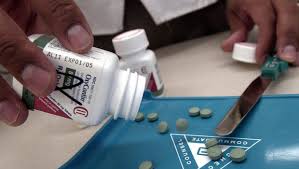Rehab Articles

A new study shows that addiction to prescription pain medication is something that a lot of primary care physicians do not understand, even though these same physicians are the top prescribers of these drugs in many areas. The survey showed that a significant number of PCPs do not have a basic understanding of how opioid abuse occurs or about the addiction potential that this class of drugs can have. According to the leader of the study, Johns Hopkins Bloomberg School’s Department of Epidemiology associate professor and Center for Drug Safety and Effectiveness co-director Caleb Alexander, M.D., M.S., “Physicians and patients may mistakenly view these medicines as safe in one form and dangerous in another, but these products are addictive no matter how you take them. If doctors and patients fail to understand this, they may believe opioids are safer than is actually the case and prescribe them more readily than they should.”
The latest prescription pain medication study shows the continuing efforts to understand, identify, and treat opioid addiction in the communities across America. Opiod abuse and addiction has been on the rise, and so has the amount of these drugs on the street. Dr. Alexander continued by saying “Doctors continue to overestimate the effectiveness of prescription pain medications and underestimate their risks, and that’s why we are facing such a public health crisis. Opioids serve an important role in the treatment of some patients. However, our findings highlight the importance of patient and provider education regarding what abuse-deterrent products can and cannot do. When it comes to the opioid epidemic, we must be cautious about overreliance on technological fixes for what is first and foremost a problem of overprescribing.” Alexander also stated “Despite the high levels of support, there are many barriers to implementation and there may be reluctance to translate these changes into real-world practice. But for the sake of making a dent in an epidemic of injuries and deaths, we have to find ways to make changes. Too many lives are at stake to stick with the status quo.”
Rehab Articles

morphine, morphine addiction, prescription pain medication
Morphine is a strong narcotic prescription pain medication that is manufactured from the opium poppy, and this drug can be highly addictive. Often a morphine addiction develops because the individual has a medical condition that requires strong prescription pain medication. Over time dependence on morphine will usually develop and the individual builds up a tolerance for the morphine. A stronger dose or more frequent dosage schedule may be needed to get the same effect. Eventually the individual has a full blown morphine addiction that impacts every area of their life. When the physician stops prescribing the drug then the user may turn to street sources, or even start using heroin as a substitute. If morphine addiction treatment is not sought the person will just continue to get worse in most cases.
Morphine addiction is treated the same as other prescription pain medication addictions. Normally inpatient rehab is the best option. Some facilities and programs may offer replacement therapy or methadone treatment in order to wean the individual off the opiate drug slowly and prevent severe cravings. Substance abuse treatment should always include individual counseling several times a week, group therapy just as frequently, and a variety of other treatment options to help you heal and fully recover. Anger Management, stress relief, nutritional counseling, equine therapy, musical appreciation, arts and crafts, and many other possible treatment choices can identify the best morphine addiction treatment programs. If you or a loved one has a problem with morphine or other types of prescription pain medication then there is help available.
Rehab Articles

prescription drug abuse, prescription pain medication
The United States Food and Drug Administration, or USFDA, recently announced changes in the labeling requirements for long term prescription pain medications. These drugs are responsible for much of the increase in prescription drug abuse in North America. The changes are due to take effect at the end of 2014, and the new label requirements are designed to make physicians think carefully before prescribing a long acting opiate medication. Oxycontin, morphine, and Fentanyl are some of the drugs that will be affected by the new labeling requirements. Along with the labeling changes the government agency is also requiring the drug manufacturers to conduct studies on the long term effects of long acting prescription drugs. Until no there have not been any studies to show the long term effects of being on these prescription medications.
Safe prescribing practices have not been established with long acting prescription painkillers because there is a lack of data on the long term effects. The new labels will have modified language to help physicians determine when these drugs are required and lower the risk of prescription drug abuse. According to Dr. Douglas Throckmorton of the F.D.A.’s Center for Drug Evaluation and Research “What is moderate to me could be severe to you. The new language will say that the drugs should be reserved for use in patients who do not have other treatment options, and be used for management of pain that is “severe enough” to require round-the-clock treatment.” Hopefully the changes will reduce prescription drug abuse in North America.



